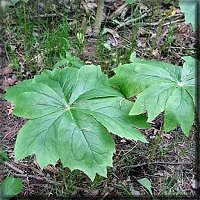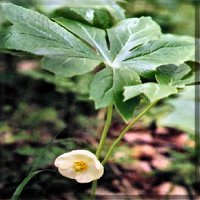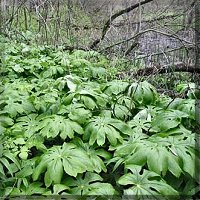







Podophyllum peltatum
Other Names - American Mandrake, Bajialian, Ducks Foot, Ground Lemon, Hog Apple, Indian Apple, Lang-tu, Love Apples, Mandragora, Mandrake, Mayapple, Podophyllin, Podophyllum, Racoon Berry, Umbrella Plant, Wild Lemon, Wild Mandrake.
Description - this perennial grows one to two feet tall. One or two large leaves unfold like umbrellas, and a solitary white blossom forms below them. The mayapple's rhizome is thick and reddish brown. Its fruit is small and yellow. The umbrella like leaves of the mayapple are a common sight in woodlands, where the plant is native. Mayapple was well known to North American Indians, who valued it for its powerful laxative effect, as a treatment for intestinal worms, as a cure for warts, and even as an insecticide for use on their crops. Apparently the Indians recognized mayapple's toxic qualities; it is said that they sometimes ate the roots and shoots to commit suicide.
Indians also ate the mayapple's fruits (the only part of the plant that is not poisonous), as many people do to this day. Some, however, say they are insipid. One 19th-century botanist dismissed them as "somewhat mawkish, beloved of pigs, raccoons, and small boys."
The plant's creeping rhizome, pencil-thin and up to 6 feet long, is the part that is used for medicinal purposes. Gathered in autumn as the plants are dying down, the rhizomes are dried and crushed into a powder. Although the remedy has traditionally been used to treat conditions ranging from liver ailments to cancers, mayapple remains best known as a laxative. But its purgative action is so strong that the U. S. Food and Drug Administration lists this use of the plant as "unsafe." Parts Used - Fruit and Rhizome.
Pharmacology - Mayapple, which is often called American mandrake, is very different from European mandrake. They have very different properties and different uses. They are not interchangeable. The mayapple is perennial plant in the barberry family (Berberidaceae). The plants long, thin rhizome is the most poisonous part, but also the most useful (since the 1820's the plant has been recognized as being of medicinal value in the official U.S.A Pharmacopoeia) because it contains high concentrations of the compounds podophyllotoxin and alpha and beta peltatin, all of which have anti-cancer properties. During the last twenty or thirty years, attention has been drawn by pharmacologists and medical researches to the fact that Podophyllum contains chemical agents responsible for anti-cancer activity. The lignans in mayapple - podophyllotoxin in particular - act against tumors and have been extensively researched for their anticancer potential. Semi synthetic derivatives of podophyllotoxin appear to be the most promising, having minimal toxicity. Constituents - The rhizome of mayapple contains lignans (especially podophyllotoxin), flavonoids, resin, and gums. The lignans are responsible for the rhizome's purgative action. Some preparations are used for treatment of venereal wart (Condyloma acuminatum) and skin Cancers.
Homeopathy - The first homeopathic proving was made in the 19th century and the remedy is used to treat digestive problems. Podophyllum acts mainly on the duodenum, the small intestine, the liver, and rectum. It is given for stomach flu with colicky pain, bilious vomiting, and diarrhea, or if the liver region is sensitive due to inflammation or gallstones. People who need Podophyllum tend to clench and grind their teeth, and it is a useful remedy for difficult teething. Complaints typically alternate, for example, constipation and diarrhea.
Medical Uses - Mayapple gets its Latin name from the Greek words podos and phyllon (foot-shaped leaves); peltatum means "shield like". While the mayapple's ripe fruit is edible, and jellies and juices are prepared from it, the root, leaves, seeds, and unripe fruit all can be poisonous. To encourage children to stay away from the poisonous mayapple, their elders traditionally taught them that it was tended by the devil. Native Americans used the root, the fruit, or decoctions of the whole plant as insecticides.
Native North American tribes drank a brew made from the dried, ground rhizome as a treatment for intestinal worms, as an antidote for snakebite, and as a laxative. This herb was formerly used as one of the laxative ingredients in the over -the-counter medication called "Carter's Little Liver Pills." Extracts of mayapple are currently administered externally to treat genital warts and some skin cancers. Podophyllotoxin, a potentially lethal component of mayapple, blocks cell division and has tumor-inhibiting properties. Two medications derived from it are approved for use in the United States. Etoposide is used to treat testicular and small-cell lung cancer. Teniposide is employed with brain tumors and childhood leukemia. The FDA has warned against mayapple as a laxative because of its potential toxicity.
Despite 19th-century beliefs in its safety, American mandrake is no longer taken internally because of its cytotoxic (cell-killing) action. However, applied externally as a poultice, lotion, or ointment, the root can be an effective treatment for all kinds
Toxic Principle: Podophyllin Poisining